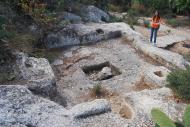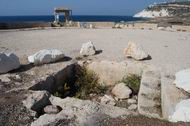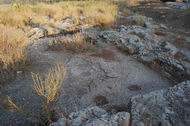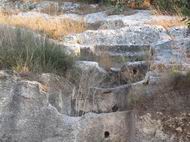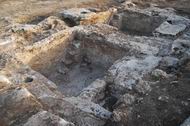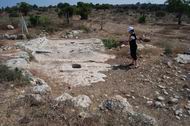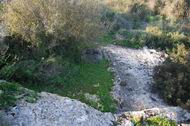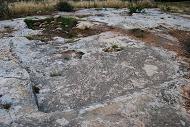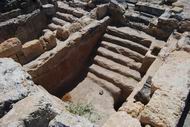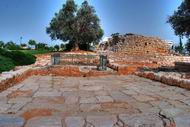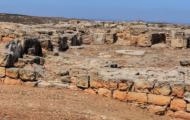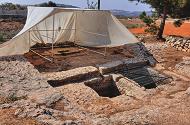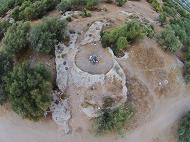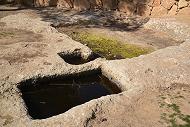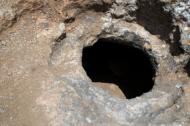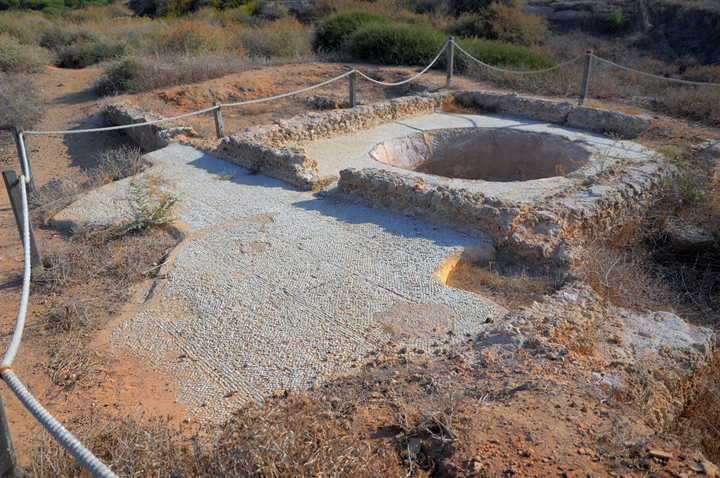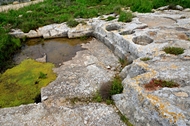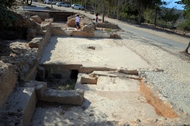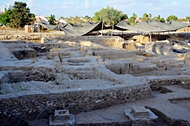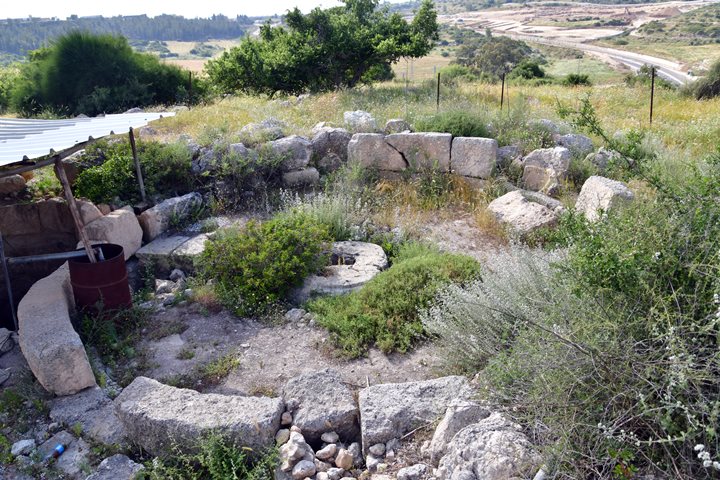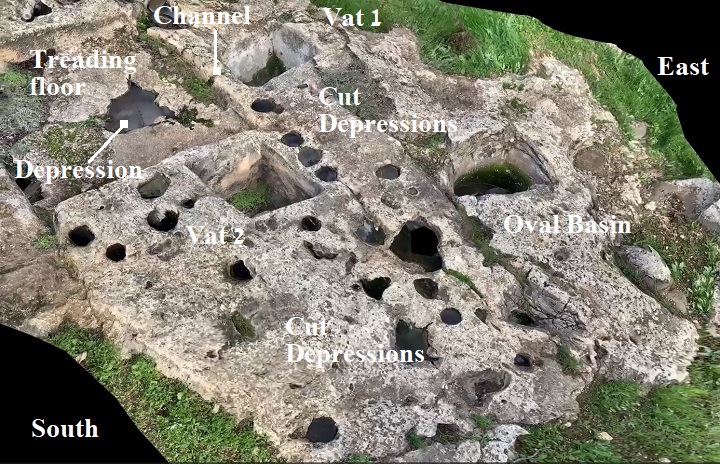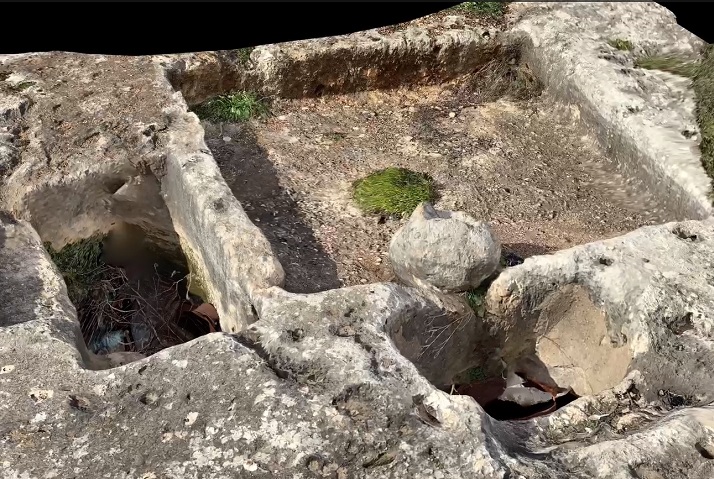Wine production was a popular industry in the Holy Land. Many winepresses are found in most of the Biblical places and ancient sites.
Isaiah 5:2: “And he fenced it, and gathered out the stones thereof, and planted it with the choicest vine, and built a tower in the midst of it, and also made a winepress therein: and he looked that it should bring forth grapes, and it brought forth wild grapes”.
Home > Info > Structures > Wine Presses
Contents:
Overview
History
Structure
Sites with Winepresses
Sample winepresses
Biblical references
Etymology
Links
Overview:
Winepresses were an important feature of ancient Israel, as wine was a staple in the Mediterranean diet and an important part of religious ceremonies. In fact, the production of wine was so important that the Bible frequently mentions it, and it was even used as a metaphor for God’s blessings.
Archaeological evidence shows that winepresses were widespread in ancient Israel, and they varied in size and complexity depending on the region and the time period. Typically, a winepress would consist of a pit or basin where grapes were crushed and a channel or trough where the juice would flow. The juice would then be collected in a vat or jar for fermentation.
Some winepresses were simple and could be operated by hand, while others were larger and required animal power to operate. The size and complexity of the winepress would depend on the amount of grapes being processed and the resources of the owner.
The location of a winepress was also important, as it needed to be close to the vineyards to minimize the time and effort required to transport the grapes. Winepresses were often located on hillsides, where the grapes could be easily brought down from the vineyards.
History:
- Prehistory
Wine was first produced in 6,000 BC in the area of Mesopotamia. During the Biblical times (Iron/Persian Age) the wine making industry was wide spread in the Holy Land and was one of the largest exports.
- Biblical
The Bible has dozens of references to wine, wine making and winepresses. The first reference is of Noah, the World’s first winemaker (Genesis 9 21-22: “And Noah … planted a vineyard: And he drank of the wine, and was drunken…”).
Initially the winepresses were small and installed in the fields near the vineyards, normally cut into the local stone. Later, some of the villages evolved around the winepresses, and even became cities bearing the name of the winepress. Clusters of winepresses, with 3 or more systems, were later installed at central industrial areas, or were installed close to the ports along the sea.
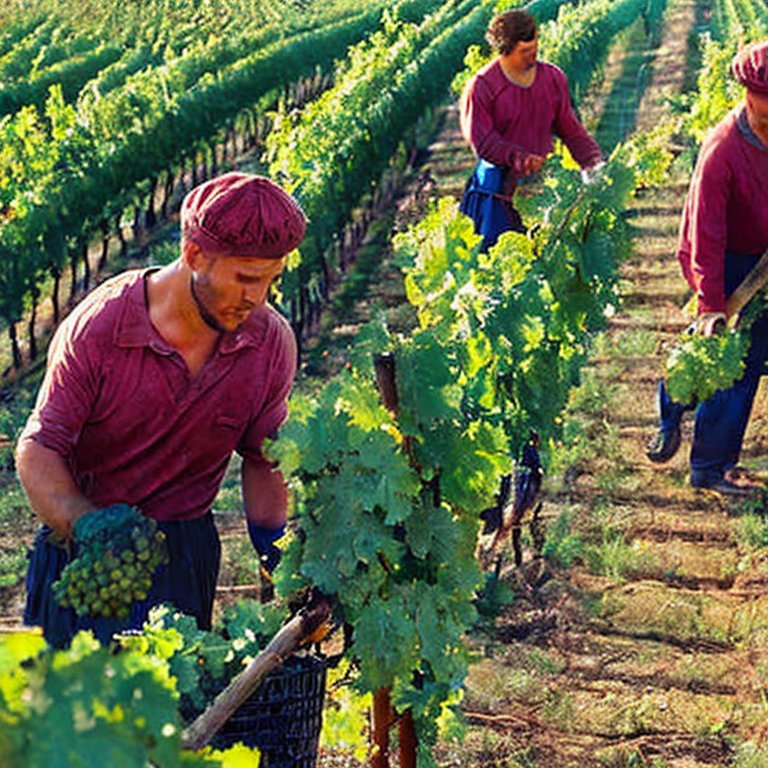
Picking grapes in a vineyard – AI generated by Stable Diffusion
- Roman/Byzantine
The number of winepresses increased considerably during the Roman/Byzantine period, and its production and export was one of the leading incomes. Hundreds of winepresses are found in the fields, villages and the cities of the Holy Land.
One of the reasons for the large demand was due to the Roman Legionnaires stationed in Israel. As per our wine expert, Uncle Ofer, each Roman soldier consumed a liter per day, or 6,000 liters per day for one Legion stationed in the Galilee. The wine has medical advantages – killing bacteria and making the drinking water safer. The wine was often diluted with equal portion of water, and used as their drinking water, keeping the soldiers healthy (and happy). This may have been one of the Roman soldiers advantages in the battlefield. To supply this demand the wine was produced in a short period of a month or so, producing a low alcohol (4%) sour wine.
Most of the vineyards and winepresses were located in the hills of the lower and upper Galilee, the Golan, the Sharon and the hills of Judea.
- Arab periods
The wine production ceased completely during the Arab conquest starting in the 8th century. Islamic faith prohibits the consumption of alcohol. Only during the Crusades the wine production was resumed for a brief time (12th – 13th century).
- Modern times
In the recent 10 years, wine making is booming again in Israel. The number of wine makers increased from a handful to over 175 (25 commercial wineries and 150 boutique wineries) and rising. Once again the Holy Land is returning to a world class wine status.
Structure of winepress:
The typical ancient winepress consists of the following elements:
- Collection Area – where the grapes are brought from the vineyard- normally a large flat area near the winepress.
- Treading floor – a large area, normally covered by mosaics, where the grapes are laid and crushed by the feet of the workers, extracting the juice. The juice, together with the crushed grapes, were left for preliminary fermentation (as suggested by Yeshu Drey). Use of shoes was avoided in order to prevent crushing the grape seeds, thus making the wine bitter.
- A small hole in the center of the treading floor – for secondary crushing of the grapes, using a single fixed-screw press. The press squeezed out the must left in the grape skins and stalks after treading. (Thanks for Rafi Frankel for his correction).
- Optional pole holes on the side of the floor – to provide a shade for the workers
- A pipe or canal that lets the grape juice flow down to the collecting pool through the filter
- A filter hole – used first to block the juice during the fermentation process. Then, to let only the juice flow through, while the grape shell and pits remain in the treading floor
- A collecting pool – where the juice is accumulated and undergo the secondary fermentation process. It is usually covered by a mosaic floor, and covered. The pool is lower than the treading floor, so the juice flows down into the pool.
- Steps that lead to the bottom of the pool – used by the workers to collect the juice into jars, and clean the pool
- Jars – to store the juice for subsequent fermentation
- Cool storage area, such as a cave – to store the jars

Sites with Winepresses:
The following lists a sample of the sites with winepresses that are featured in BibleWalks. Click on the site’s name to see more information on each site.
- The treading floor is hidden under the sand. The smaller hole – the filtration pit – has a mosaic floor. The larger pit has 6 steps, which allow the workers to step down and collect the juice into jars, then store them for subsequent fermentation.
- Roman Byzantine
- Several winepresses are located around the ancient city. The photo shows the grand winepress on “observation-hill”.
- Roman Byzantine
- On the eastern side of the Tell is a large winepress, among other installations and cisterns. The crushing area is a rectangular pit with a mosaic floor, typical of Roman/Byzantine wine presses.
- The Bible tells about the vineyard of Naboth in the city of Yizreel (Jezreel), and how Ahab and Jezebel plotted to posses it. This winepress may have been located in the famous vineyard.
- Roman Byzantine
- Salvage excavations uncovered one of the largest Industrial winepress complexes in Israel. Its size is 9.5 x 40M. This indicates that the city was one of the major wine centers, and exported its wine through the local port of Achziv.
- Late Roman
- The agriculture industry relied on wine presses, and 8 bronze-age presses were found cut into the rock. All the presses were based on a similar simple design. On the top side of the wine press was a steep rectangular floor where the grapes were arranged. The workers squashed the grapes with their feet, then left in the floor. After the fermentation the juice would flow down to the lower side, through a filter hole and into a collecting basin.
- Bronze period
- The site is located on a sandstone ridge, on the coast of Mt Carmel. A cluster of 3 winepresses were unearthed in the salvage excavations of 2007.
- Byzantine
- A group of 3 winepresses are located on the east side of the village. The complex shares a common collecting vat.
- Roman
- Just south to the road to new Avdon is a large rock-hewn winepress. The treading floor is a 4x4m cavity cut into the rock, and covered with mosaic stones, as seen below. There is also a square collecting vat with wide ledge cut into the side of the collecting vat.
- Roman
- Ruins of a Byzantine monastery, located on a hill in the center of Karmi’el. On the foothills are several winepresses cut into the rock.
- Byzantine
Hippos (Sussita)
- A large winepress near the city’s forum, with two basins and treading floor.
- Byzantine
- Ruins of a Byzantine monastery, located in an archaeological park in the west side of Karmi’el. A large treading floor and collecting pool was excavated near the church.
- Byzantine
- A winepress was part of the Byzantine monastery on Mt Gerizim. This complex is located on the south side of the Church.
- Byzantine
- An impressive rock hewn winepress, 300m south of the Holy site of Tel Shiloh.
- EarlyRoman
- One of the largest wine presses in Israel.
- Roman Byzantine
- The winepress is cut into the rock. It consists of a large treading (crushing) floor, 10 M2.
- Roman Byzantine
- Underground wine cellars (Gibeon type)
- First temple
Apollonia (Arsuf)
- A large Samaritan winepress dated to the 5th-6th century AD was unearthed north of the castle. It includes a large treading floor paved with mosaics, and a very large fermentation pit.
- Byzantine
- Two wine press installations, operated by the monastery
- Byzantine
- Large winepress, 14.8m by 8.0m. Operated by a monastery on the side of the “Caesar’s way” to Jerusalem.
- Byzantine
A huge winery factory, dated to the Byzantine period, was unearthed here. This is the largest ancient winery found to date in the world, producing an estimated 2 million liters per year.
On a hill above highway #38, 1km north west of Beit Jamal, are remains of a unique Byzantine period industrial winepress.
Sample sites:
A sample of winepresses are shown here.
(a) Tel Jezreel Iron Age winepress
An Iron Age winepress was recently unearthed on Tel Yizreel (Jezreel). This may have been used in the famous Biblical vineyard (1 Kings 21:1): “And it came to pass after these things, that Naboth the Jezreelite had a vineyard, which was in Jezreel”.
The winepress was cut into the limestone bedrock. The archaeologists date this installation to the first half of the first millennium BC, during the latter part of the Iron Age. Within an area of 12m x 12m they revealed a treading floor (3.2m x 3.2m), an attached wine vat (“Vat1” – 1.35m x 1.2m and 1.55m deep), another vat that was abandoned due to a basalt bolder they encountered inside (“Vat 2” – 1.3 x 1.2m and 1.26 deep), a deep oval basin (90cm diameter, 1.4m deep), and 20 rock-cut depressions (about 20cm rim diameter, 50cm deep).
Pressing on the following photo will open a mp4 video player where the model can be viewed from different angles. Use pinch & stretch to magnify the view.
3D model of the Iron Age winepress – scanned by Scaniverse app on iPad Air Dec 2023
(b) Roman/Byzantine Age winepress
Another rock-hewn winepress is found west of the Arab village of Zububa in Northern Samaria, dated to the Roman/Byzantine period. In the area around the site are many similar winepresses that were constructed near the vineyards.
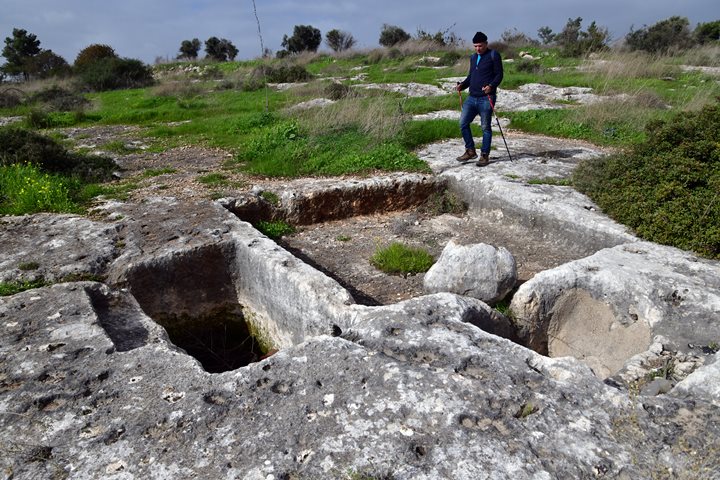
The installation includes a treading floor with a hole in its center for 2nd crushing, and two collecting pools with a filtration hole separating the treading floor and the wine vats.
A 3D model of this winepress is seen below. Pressing on the following photo will open a mp4 video player. After it turns around, use the player to rotate it.
3D model of the Roman/Byzantine winepress – scanned by Scaniverse
Biblical references:
These are dozens of references to wine, and many others for winepresses. Wine is significant to Jewish and Christian cultures. Wine making was one of the important industries in the Biblical times –
Num 18:27: “And this your heave offering shall be reckoned unto you, as though it were the corn of the threshingfloor, and as the fulness of the winepress“.
Num 18:30: “Therefore thou shalt say unto them, When ye have heaved the best thereof from it, then it shall be counted unto the Levites as the increase of the threshingfloor, and as the increase of the winepress“.
Deut 15:14: “Thou shalt furnish him liberally out of thy flock, and out of thy floor, and out of thy winepress: of that wherewith the LORD thy God hath blessed thee thou shalt give unto him”.
Judg 6:11: “And there came an angel of the LORD, and sat under an oak which was in Ophrah, that pertained unto Joash the Abiezrite: and his son Gideon threshed wheat by the winepress, to hide it from the Midianites”.
Judg 7:25: “And they took two princes of the Midianites, Oreb and Zeeb; and they slew Oreb upon the rock Oreb, and Zeeb they slew at the winepress of Zeeb, and pursued Midian, and brought the heads of Oreb and Zeeb to Gideon on the other side Jordan”.
Judg 9:27: “And they went out into the fields, and gathered their vineyards, and trode the grapes, and made merry, and went into the house of their god, and did eat and drink…”.
2 Kings 6:27: “And he said, If the LORD do not help thee, whence shall I help thee? out of the barnfloor, or out of the winepress?”
Job 24:11: “Which make oil within their walls, and tread their winepresses, and suffer thirst”.
Is 5:2: “And he fenced it, and gathered out the stones thereof, and planted it with the choicest vine, and built a tower in the midst of it, and also made a winepress therein: and he looked that it should bring forth grapes, and it brought forth wild grapes”. It is recommended to read the whole chapter, since it revolves around wine.
Is 63:3: “I have trodden the winepress alone; and of the people there was none with me: for I will tread them in mine anger, and trample them in my fury; and their blood shall be sprinkled upon my garments, and I will stain all my raiment”.
Jer 48:33: “And joy and gladness is taken from the plentiful field, and from the land of Moab, and I have caused wine to fail from the winepresses: none shall tread with shouting; their shouting shall be no shouting”.
Lam 1:15: “The LORD hath trodden under foot all my mighty men in the midst of me: he hath called an assembly against me to crush my young men: the LORD hath trodden the virgin, the daughter of Judah, as in a winepress“.
Hos 9:2: “The floor and the winepress shall not feed them, and the new wine shall fail in her”.
Zech 14:10: “All the land shall be turned as a plain from Geba to Rimmon south of Jerusalem: and it shall be lifted up, and inhabited in her place, from Benjamin’s gate unto the place of the first gate, unto the corner gate, and from the tower of Hananeel unto the king’s winepresses“.
Mt 21:33: “Hear another parable: There was a certain householder, which planted a vineyard, and hedged it round about, and digged a winepress in it, and built a tower, and let it out to husbandmen, and went into a far country”
Rev 14:19: “And the angel thrust in his sickle into the earth, and gathered the vine of the earth, and cast it into the great winepress of the wrath of God”.
Rev 14:20: “And the winepress was trodden without the city, and blood came out of the winepress, even unto the horse bridles, by the space of a thousand and six hundred furlongs”.
Rev 19:15: “And out of his mouth goeth a sharp sword, that with it he should smite the nations: and he shall rule them with a rod of iron: and he treadeth the winepress of the fierceness and wrath of Almighty God”.
Etymology (behind the name):
- Ya-in – Wine in Hebrew; probably the source of the word “wine”.
- Gath, Gat – press in Hebrew, normally a winepress (although it may refer to oil and Pomegranateas-Rimon well). There are many sites with the prefix Gath, such as: Gath, Gittaim, Gat-Asher, Gat-Rimmon, GathGathsemane, Gat-Carmel, Jat.
- Anav (Anavim in plural) – grape in Hebrew. There are sites with this prefix, such as: Anav, Kiryat-Anavim.
- Tirosh – grape juice in Hebrew.
Links:
* History of wine:
- Wine & Oil Production in Antiquity in Israel & other Med. Countries [ISBN 1850755191 1998]Frankel, Rafael.
- Wine in the Bible
- Origins and history of wine
- Origins and Ancient history of Wine
- Yeshu Dray‘s restoration of Ancient Technology
- An ancient winery at Jezreel – JEMAH, Vol 8, No 1, 2020 pp 6-25 (N. Franklin et al.)
* General Wine links:
- Wine grape varieties – 20 popular types
BibleWalks.com – exploring the Bible places in Israel
Mills <<<—Previous info—<<< All Info >>>—Next—>>> Oil Presses
This page was last updated on Nov 17, 2024 (comment update)
Sponsored links:
